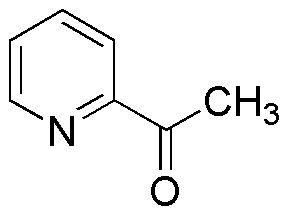2-Acetylpyridine is widely utilized in research focused on:
- Flavor and Fragrance Industry: This compound is used as a flavoring agent in food products and as a fragrance component in perfumes due to its pleasant aroma, enhancing sensory experiences.
- Pharmaceuticals: It serves as an intermediate in the synthesis of various pharmaceuticals, contributing to the development of medications with improved efficacy and reduced side effects.
- Agricultural Chemicals: 2-Acetylpyridine is employed in the formulation of agrochemicals, particularly as a building block for developing herbicides and pesticides, helping to improve crop yield and protection.
- Coordination Chemistry: This compound is used in the preparation of metal complexes, which are essential in catalysis and materials science, offering unique properties for various applications.
- Research and Development: It is a valuable reagent in organic synthesis, aiding researchers in developing new compounds and materials, thus driving innovation in chemical research.
General Information
Properties
Safety and Regulations
Applications
2-Acetylpyridine is widely utilized in research focused on:
- Flavor and Fragrance Industry: This compound is used as a flavoring agent in food products and as a fragrance component in perfumes due to its pleasant aroma, enhancing sensory experiences.
- Pharmaceuticals: It serves as an intermediate in the synthesis of various pharmaceuticals, contributing to the development of medications with improved efficacy and reduced side effects.
- Agricultural Chemicals: 2-Acetylpyridine is employed in the formulation of agrochemicals, particularly as a building block for developing herbicides and pesticides, helping to improve crop yield and protection.
- Coordination Chemistry: This compound is used in the preparation of metal complexes, which are essential in catalysis and materials science, offering unique properties for various applications.
- Research and Development: It is a valuable reagent in organic synthesis, aiding researchers in developing new compounds and materials, thus driving innovation in chemical research.
Documents
Safety Data Sheets (SDS)
The SDS provides comprehensive safety information on handling, storage, and disposal of the product.
Product Specification (PS)
The PS provides a comprehensive breakdown of the product’s properties, including chemical composition, physical state, purity, and storage requirements. It also details acceptable quality ranges and the product's intended applications.
Certificates of Analysis (COA)
Search for Certificates of Analysis (COA) by entering the products Lot Number. Lot and Batch Numbers can be found on a product’s label following the words ‘Lot’ or ‘Batch’.
*Catalog Number
*Lot Number
Certificates Of Origin (COO)
This COO confirms the country where the product was manufactured, and also details the materials and components used in it and whether it is derived from natural, synthetic, or other specific sources. This certificate may be required for customs, trade, and regulatory compliance.
*Catalog Number
*Lot Number
Safety Data Sheets (SDS)
The SDS provides comprehensive safety information on handling, storage, and disposal of the product.
DownloadProduct Specification (PS)
The PS provides a comprehensive breakdown of the product’s properties, including chemical composition, physical state, purity, and storage requirements. It also details acceptable quality ranges and the product's intended applications.
DownloadCertificates of Analysis (COA)
Search for Certificates of Analysis (COA) by entering the products Lot Number. Lot and Batch Numbers can be found on a product’s label following the words ‘Lot’ or ‘Batch’.
*Catalog Number
*Lot Number
Certificates Of Origin (COO)
This COO confirms the country where the product was manufactured, and also details the materials and components used in it and whether it is derived from natural, synthetic, or other specific sources. This certificate may be required for customs, trade, and regulatory compliance.


